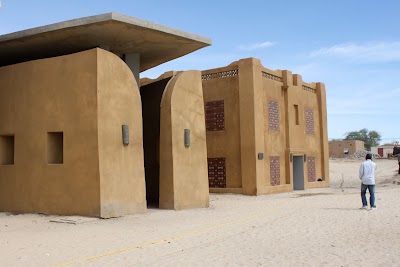Gao Ancient City (مدينة غاو القديمة)
Overview
Discovering Gao Ancient City
Gao Ancient City, nestled in the Taoudénit Region of Mali, is a captivating destination that offers a window into West Africa's rich historical tapestry. Once a thriving hub of commerce and culture, this city invites tourists to explore its storied past and intriguing relics. Established as early as the 9th century, Gao became the heart of the powerful Songhai Empire, a key player in trans-Saharan trade.
The Historical Significance of Gao
Gao's historical importance is closely linked to its strategic position along the Niger River, which facilitated the exchange of goods, ideas, and cultures. Flourishing as a major trading center, the city connected the sub-Saharan world with the Mediterranean and the Middle East. Merchants from Africa, Arabia, and Europe converged here, trading in salt, gold, ivory, and slaves, making Gao one of the wealthiest cities of its era.
Iconic Landmarks: Askia Tomb
Upon visiting Gao, you'll be struck by the monumental Askia Tomb. This impressive pyramid-like structure was built by Askia Mohammed, the first emperor of the Askia Dynasty, following his pilgrimage to Mecca in 1495. The tomb is not just a remarkable architectural feat but also a symbol of the cultural influences that have shaped the region. Designated a UNESCO World Heritage site, it underscores Gao's global significance.
The Great Mosque of Gao
Another essential site is the Gao Mosque, also known as the Great Mosque of Gao or the Sankore Mosque. Constructed from mudbrick and wood, this ancient mosque exemplifies the Sahelian architectural style endemic to the region. Visitors are often awed by its simple yet majestic design, which has withstood the test of time. Beyond its role as a place of worship, the mosque symbolizes Gao's historical importance as a center of Islamic learning and culture.
Unearthing the Past
Gao's rich history is palpable in the remnants of the ancient city itself. Archaeological sites reveal fascinating insights into the daily lives of its inhabitants. Tourists can explore ancient pottery, tools, and the ruins of old structures, painting a vivid picture of life in this remarkable city. These artifacts forge an invaluable connection to the experiences of the people who once called Gao home.
Experiencing Local Culture
In addition to its historical allure, Gao's cultural heritage remains vibrant today. Visitors can immerse themselves in local traditions, music, and dance that reflect the diverse influences shaping the city over the centuries. Known for their hospitality, Gao's residents often welcome tourists into the heart of their community, providing a unique opportunity to engage with the living history of the area.
A Journey Worth Taking
Gao's fascinating history and cultural significance make it a must-visit destination for anyone interested in African heritage. The stories embedded in its ancient tombs, mosques, and ruins are treasures waiting to be discovered. Whether you're wandering through bustling markets, exploring archaeological sites, or connecting with the warm locals, Gao promises an enriching experience that will leave a lasting impression.
In conclusion, Gao Ancient City is more than just a historical site; it is a living testament to the grandeur of the past and the enduring spirit of its people. Offering a unique blend of history, architecture, and culture, it is an invaluable destination for the intrepid traveler. From the monumental Askia Tomb to the venerable Gao Mosque and the vibrant local culture, Gao guarantees an unforgettable journey into the heart of Mali's historical legacy.





